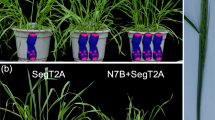Abstract
Position effect variegation (PEV) is a perturbation of genes expression resulting from the changes in their chromatin organization due to the abnormal juxtaposition with heterochromatin. The exact molecular mechanisms of PEV remain enigmatic in spite of the long history of PEV studies. Here, we developed a genetic model consisting of PEV-inducing chromosome rearrangement and a reporter gene under control of the UAS regulatory element. Expression of the reporter gene could be regulated by adjustment of the GAL4 transactivator activity. Two UAS-based systems of expression control were tested–with thermosensitive GAL4 repressor GAL80ts and GAL4-based artificial transactivator GeneSwitch. Both systems were able to regulate the expression of the UAS-controlled reporter gene over a wide range, but GAL80ts repressed the reporter gene more efficiently. Measurements of the heterochromatin-mediated repression of the reporter gene in the GAL4+GAL80ts system point to the existence of a threshold level of expression, above which no PEV is observed.
Similar content being viewed by others
Abbreviations
- PEV:
-
position effect variegation
- UAS-eGFP-Ret :
-
insertion of the reporter gene UAS-eGFP in the Ret gene
References
Elgin, S. C., and Reuter, G. (2013) Position-effect variega-tion, heterochromatin formation, and gene silencing in Drosophila, Cold Spring Harb. Perspect. Biol., 5, a017780.
Muller, H. J. (1930) Types of visible variations induced by X-rays in Drosophila, J. Genet., 22, 299.
Spofford, J. B. (1976) Position-effect variegation in Drosophila, in The Genetics and Biology of Drosophila, Academic Press.
Weiler, K. S., and Wakimoto, B. T. (1995) Heterochromatin and gene expression in Drosophila, Annu. Rev. Genet., 29, 577–605.
Zhimulev, I. F., Belyaeva, E. S., Fomina, O. V., Protopopov, M. O., and Bolshakov, V. N. (1986) Cytogenetic and molec-ular aspects of position effect variegation in Drosophila melanogaster, Chromosoma, 94, 492–504.
Prokofyeva-Belgovskaya, A. A. (1945) Heterochromatini-zation as a change of chromosome cycle, Zh. Obshch. Biol., 4, 93–124 (Russian version)
Prokofyeva-Belgovskaya, A. A. (1947) Heterochromatinization as a change of chromo-some cycle, J. Genet., 48, 80–98 (English version).
Reuter, G., and Spierer, P. (1992) Position effect variega-tion and chromatin proteins, Bioessays, 14, 605–612.
Singh, J., Freeling, M., and Lisch, D. (2008) A position effect on the heritability of epigenetic silencing, PLoS Genet., 4, e1000216.
Abramov, Y. A., Shatskikh, A. S., Maksimenko, O. G., Bonaccorsi, S., Gvozdev, V. A., and Lavrov, S. A. (2016) The differences between cis-and trans-gene inactivation caused by heterochromatin in Drosophila, Genetics, 202, 93–106.
Lavrov, S. A., Shatskikh, A. S., Kibanov, M. V., and Gvozdev, V. A. (2013) Correlation on a cellular level of gene transcriptional silencing and heterochromatin compart-ment dragging in case of PEV-producing eu-heterochro-matin rearrangement in Drosophila melanogaster, Mol. Biol. (Moscow), 47, 286–291.
Abramov, Y. A., Kibanov, M. V., Gvozdev, V. A., and Lavrov, S. A. (2011) Genetic and molecular analysis of gene trans-inactivation caused by homologous eu-heterochro-matic chromosome rearrangement in Drosophila melanogaster, Dokl. Biochem. Biophys., 437, 72–76.
Csink, A. K., Bounoutas, A., Griffith, M. L., Sabl, J. F., and Sage, B. T. (2002) Differential gene silencing by trans-heterochromatin in Drosophila melanogaster, Genetics, 160, 257–269.
Csink, A. K., and Henikoff, S. (1996) Genetic modification of heterochromatic association and nuclear organization in Drosophila, Nature, 381, 529–531.
Talbert, P. B., Leciel, C. D., and Henikoff, S. (1994) Modification of the Drosophila heterochromatic mutation brownDominant by linkage alterations, Genetics, 136, 559–571.
Henikoff, S., and Dreesen, T. D. (1989) Trans-inactivation of the Drosophila brown gene: evidence for transcriptional repression and somatic pairing dependence, Proc. Natl. Acad. Sci. USA, 86, 6704–6708.
Mcguire, S. E., Le, P. T., Osborn, A. J., Matsumoto, K., and Davis, R. L. (2003) Spatiotemporal rescue of memory dysfunction in Drosophila, Science, 302, 1765–1768.
Fujimoto, E., Gaynes, B., Brimley, C. J., Chien, C. B., and Bonkowsky, J. L. (2011) Gal80 intersectional regulation of cell-type specific expression in vertebrates, Dev. Dyn., 240, 2324–2334.
Osterwalder, T., Yoon, K. S., White, B. H., and Keshishian, H. (2001) A conditional tissue-specific transgene expres-sion system using inducible GAL4, Proc. Natl. Acad. Sci. USA, 98, 12596–12601.
Roman, G., Endo, K., Zong, L., and Davis, R. L. (2001) P[Switch], a system for spatial and temporal control of gene expression in Drosophila melanogaster, Proc. Natl. Acad. Sci. USA, 98, 12602–12607.
Bischof, J., Maeda, R. K., Hediger, M., Karch, F., and Basler, K. (2007) An optimized transgenesis system for Drosophila using germ-line-specific phiC31 integrases, Proc. Natl. Acad. Sci. USA, 104, 3312–3317.
Groth, A. C., Fish, M., Nusse, R., and Calos, M. P. (2004) Construction of transgenic Drosophila by using the site-spe-cific integrase from phage phiC31, Genetics, 166, 1775–1782.
Venken, K. J., Schulze, K. L., Haelterman, N. A., Pan, H., He, Y., Evans-Holm, M., Carlson, J. W., Levis, R. W., Spradling, A. C., Hoskins, R. A., and Bellen, H. J. (2011) MiMIC: a highly versatile transposon insertion resource for engineering Drosophila melanogaster genes, Nat. Methods, 8, 737–743.
Vogel, M. J., Pagie, L., Talhout, W., Nieuwland, M., Kerkhoven, R. M., and Van Steensel, B. (2009) High-reso-lution mapping of heterochromatin redistribution in a Drosophila position-effect variegation model, Epigenetics Chromatin, 2, 1.
Sage, B. T., Wu, M. D., and Csink, A. K. (2008) Interplay of developmentally regulated gene expression and hete-rochromatic silencing in trans in Drosophila, Genetics, 178, 749–759.
Author information
Authors and Affiliations
Corresponding author
Additional information
Original Russian Text © A. S. Shatskikh, O. M. Olenkina, A. A. Solodovnikov, S. A. Lavrov, 2018, published in Biokhimiya, 2018, Vol. 83, No. 5, pp. 712–723.
Originally published in Biochemistry (Moscow) On-Line Papers in Press, as Manuscript BM17-534, April 9, 2018.
Rights and permissions
About this article
Cite this article
Shatskikh, A.S., Olenkina, O.M., Solodovnikov, A.A. et al. Regulated Gene Expression as a Tool for Analysis of Heterochromatin Position Effect in Drosophila. Biochemistry Moscow 83, 542–551 (2018). https://doi.org/10.1134/S0006297918050073
Received:
Revised:
Published:
Issue Date:
DOI: https://doi.org/10.1134/S0006297918050073




